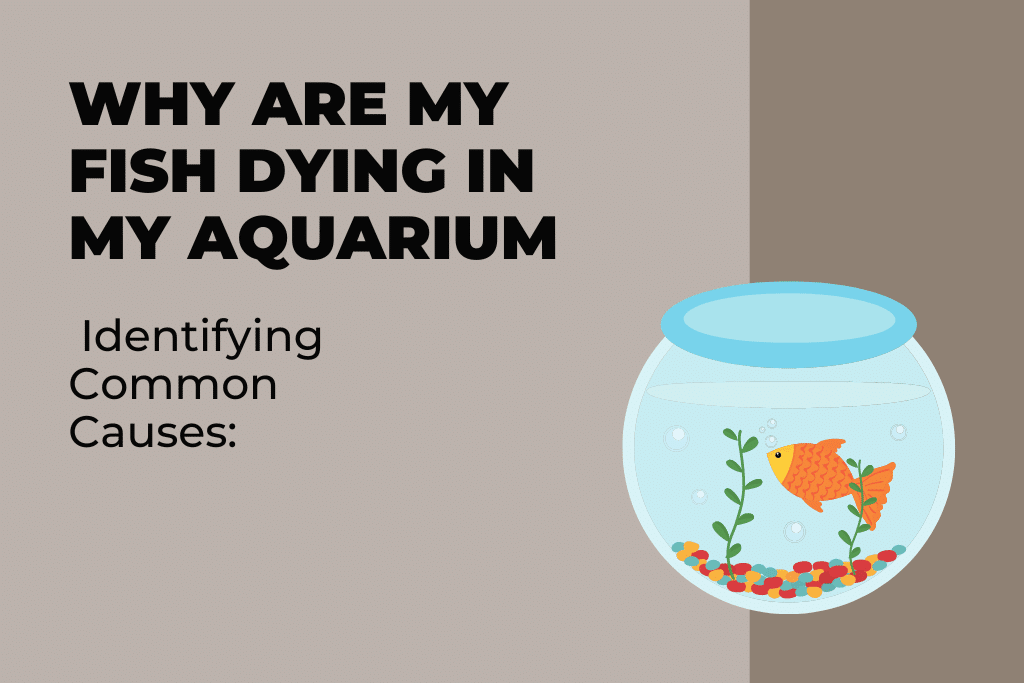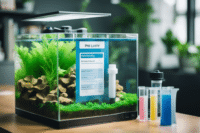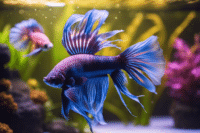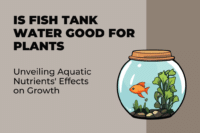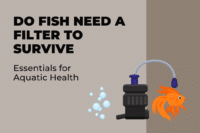Aquarium enthusiasts frequently experience the distressing experience of fish death being unexpected and without obvious cause. To maintain a healthy aquarium environment, it’s necessary to understand all factors contributing to fish wellness – such as water quality, behavior patterns and environmental conditions.
Aspiring fishkeepers should understand that multiple factors can lead to mortality in aquarium fish, including poor water conditions, diseases and stress from incompatible tankmates or overfeeding. Early identification and attention can go a long way toward preventing fish deaths in an aquarium environment if properly maintained – comprehensive monitoring will give fishkeepers peace of mind that their aquatic pets remain alive while enjoying an flourishing aquarium tank environment!
Key Takeaways
- Water quality, disease, and stress are significant contributors to fish mortality.
- Early detection and intervention are essential to prevent fish deaths.
- Regular monitoring and maintenance are key to sustaining a healthy aquarium environment.
Understanding Aquarium Basics
Understanding Aquarium Basics will assist those navigating their way around their aquarium environment.
Establishing an aquarium requires two key elements that often determine its success: Aquarium Size and Water Quality Fundamentals. Together these form the core of creating an optimal aquatic ecosystem that remains sustainable over time.
Size Matters Aquarium Size matters! A larger tank provides more stable conditions and dilutes toxins more effectively than smaller tanks, as well as providing ample swimming space for fish as well as supporting beneficial bacteria colonies for a balanced nitrogen cycle. Finally, consider what ultimate size your fish might reach so as not to leave room for growth and flourishing in an inadequate aquarium space.
Fundamentals of Water quality.
Maintenance of water quality is integral to fish health. Testing ammonia, nitrite and nitrate levels regularly enables early identification of imbalances; good bacteria play an essential part in nitrogen cycling processes that convert harmful byproducts to less toxic forms; ongoing monitoring and management of aquarium parameters create an enabling environment for these beneficial microbes and ensure overall aquarium wellbeing.
Factors in Fish Mortality
When unexpected deaths of aquarium fish occur, it can often indicate something amiss in their environment. Water quality and interactions among species play a pivotal role in maintaining their health and lifespan.
Parameters And Chemistry Of Water.
Key Water quality factors:
pH Levels: Maintaining an appropriate range for any given fish species’s appropriate pH levels is of great importance for their wellbeing; extreme pH values can lead to fish death.
Ammonia Levels: Excess ammonia poisoning from decayed organic matter or overfeeding often results in ammonia poisoning among fish populations.
Nitrite and Nitrate: Accumulations of these compounds indicate poor water quality, leading to stress and mortality among fish populations. Regular testing must take place to detect potentially hazardous levels.
Preventative Measures:
Switch out 10-20% of water every week in order to lower waste concentration. Assuring temperatures don’t fluctuate rapidly can also help avoid shock-like fish reactions and ensure aquarium inhabitants cohabit peaceably together.
Incompatible Tank Mates:
Aggression: Certain species display territorial behavior or aggression towards others, leading to stress in fish that could potentially result in injury or even death.
Competition: Overcrowding and competition for resources create a hostile environment which further adds stress levels in an already stressful setting.
Choose Tankmates Carefully: Select species that possess similar temperament and environmental needs. Allow for enough space and hiding places so as to minimize stress and aggression in their relationship.
Monitoring aquarium conditions and interactions is crucial to creating an enjoyable aquatic ecosystem and avoiding fish mortality.
Proper fish care techniques include feeding and water quality treatments.
An aquarium ecosystem must remain healthy to promote fish longevity and welfare, including feeding practices that adhere to feeding recommendations as well as proactive disease-prevention techniques to guarantee vitality of its aquatic inhabitants. Proper care for aquarium fish begins by engaging in responsible feeding habits and proactive disease protection, both of which play crucial roles.
Overfeeding fish owners is one of the primary mistakes, leading to excess uneaten food which compromises water quality and compromises their species diets. Owners should adhere to a feeding schedule tailored specifically for their species – typically small portions once or twice each day – with unattended uneaten food quickly removed to prevent an ammonia/nitrite build-up that can harm aquatic organisms.
Preventive Measures
A regular water change regimen can provide protection from fish diseases by maintaining clean environments for an immune-supportive ecosystem. You should perform 10-20% weekly changes, to rid of contaminants and keep water parameters stable; an eyeful for unusual behavior or physical symptoms from fish could indicate possible disease or parasite infestation requiring prompt action to address its spread as soon as it appears.
Common Pitfalls of Fishkeeping
Maintaining a healthy aquarium environment requires becoming familiar with all its intricate details and working to prevent neglecting key factors like environmental stability and tank setup, which could ultimately cause aquatic pets’ demise.
Aquarium Environmental Stability.
Maintaining aquarium environmental stability is vitally important to fish wellbeing. New tank syndrome occurs when newcomers arrive before beneficial bacteria have had time to settle in properly, leading to ammonia and nitrite spikes which threaten fish. Rapid water changes often exacerbate this problem further as rapid fluctuations can shock fish and throw the biological balance off balance, stressing out or killing off entire populations of aquatic life resulting in excessive hiding, weight loss or death; to avoid such issues:
Cycle your aquarium for at least six to eight weeks prior to adding new fish. Perform weekly water changes of 10-20% (to maintain quality without drastic fluctuations).
An Inappropriate Tank Setup
Improper tank setup can contribute significantly to fish mortality. This involves several aspects such as overcrowding which reduces oxygen levels, increases waste production and raises stress and disease susceptibility levels significantly, among many others. A well-conceived setup includes elements such as:
Select the proper tank size that can house their fully grown size of fish to prevent overcrowding and ensure adequate hiding spots when stressed, without creating cramped conditions.
Implement a thorough tank preparation process using suitable substrate, filtration and temperature controls tailored specifically for their fish species’ specific requirements. Adhere to an aquarium maintenance schedule to detect issues before they escalate further.
By understanding and rectifying these common fishkeeping mistakes, aquarists can substantially decrease the risks that their fish face from preventable issues.
Preventing Fish Deaths
It is imperative that an aquarium owner takes proactive and vigilant steps in order to prevent fish deaths that could otherwise have been preventable, due to poor water quality and subpar tank management practices.
Early Detection And Response Plans for Addiction Recovery.
Early recognition and detection can greatly increase the odds of fish survival, increasing chances of avoidable deaths and helping aquarium owners to prevent future fatalities. Aquarium owners should regularly observe symptoms like erratic swimming, abnormal spots on body surfaces or changes in appetite; additionally testing water parameters regularly will ensure optimal water quality requirements are being met; should any issues arise prompt responses can ensure further deaths do not occur.
Maintain Fish Habits And Appearance on a Daily Basis by Monitoring fish behaviors and appearance closely; test water quality weekly: ammonia, nitrites/nitrates and pH Levels as part of Maintenance And Management Practices
Effective aquarium management requires creating and maintaining an ideal habitat for aquatic life, with regular practices including cleaning out, maintaining stability and controlling environmental risks for their wellbeing. Following are key practices involved with managing an aquarium:
Regular Water changes: Switch out 10-25% of your tank water every two to four weeks in order to keep conditions ideal and ensure optimal conditions in the aquarium. Clean or replace filters regularly so as to eliminate waste accumulation, protect filtration system integrity and avoid build-up of harmful toxins in water supply tanks.
Avoid Overfeeding: Overfeeding can lead to waste accumulation and diminished water quality; use small, controlled feedings instead. Compatible Tank Mates: When adding new fish into an established ecosystem, make sure newcomers are compatible so as to prevent stress-induced illness in existing inhabitants.
Temperature: It is important to maintain an environment suitable for each species of fish in your tank. Aeration: Air stones or pumps should provide enough oxygenation.
Implementation of these specific strategies can substantially lower the risks of fish deaths due to preventable conditions and ensure a sustainable aquatic ecosystem.
